Xiaosong Hu
Non-destructive Degradation Pattern Decoupling for Ultra-early Battery Prototype Verification Using Physics-informed Machine Learning
Jun 01, 2024



Abstract:Manufacturing complexities and uncertainties have impeded the transition from material prototypes to commercial batteries, making prototype verification critical to quality assessment. A fundamental challenge involves deciphering intertwined chemical processes to characterize degradation patterns and their quantitative relationship with battery performance. Here we show that a physics-informed machine learning approach can quantify and visualize temporally resolved losses concerning thermodynamics and kinetics only using electric signals. Our method enables non-destructive degradation pattern characterization, expediting temperature-adaptable predictions of entire lifetime trajectories, rather than end-of-life points. The verification speed is 25 times faster yet maintaining 95.1% accuracy across temperatures. Such advances facilitate more sustainable management of defective prototypes before massive production, establishing a 19.76 billion USD scrap material recycling market by 2060 in China. By incorporating stepwise charge acceptance as a measure of the initial manufacturing variability of normally identical batteries, we can immediately identify long-term degradation variations. We attribute the predictive power to interpreting machine learning insights using material-agnostic featurization taxonomy for degradation pattern decoupling. Our findings offer new possibilities for dynamic system analysis, such as battery prototype degradation, demonstrating that complex pattern evolutions can be accurately predicted in a non-destructive and data-driven fashion by integrating physics-informed machine learning.
Feature Analyses and Modelling of Lithium-ion Batteries Manufacturing based on Random Forest Classification
Feb 10, 2021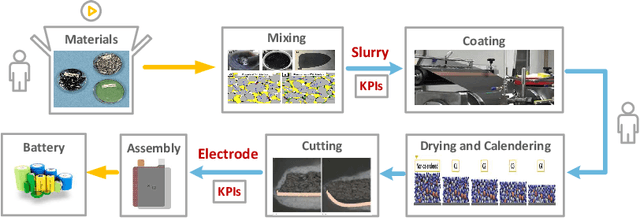
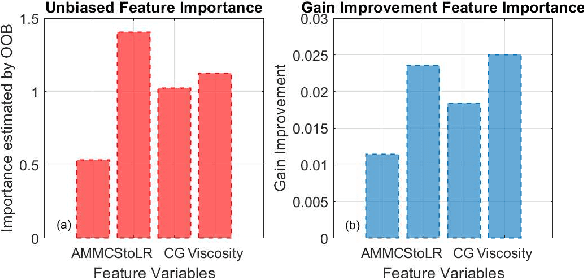
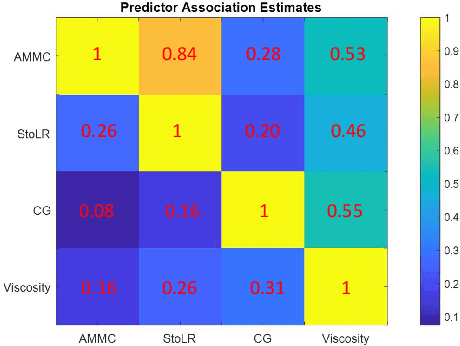
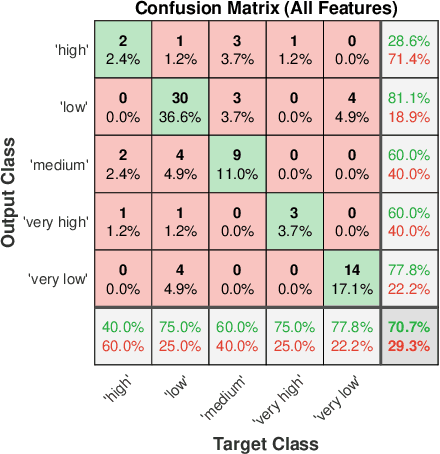
Abstract:Lithium-ion battery manufacturing is a highly complicated process with strongly coupled feature interdependencies, a feasible solution that can analyse feature variables within manufacturing chain and achieve reliable classification is thus urgently needed. This article proposes a random forest (RF)-based classification framework, through using the out of bag (OOB) predictions, Gini changes as well as predictive measure of association (PMOA), for effectively quantifying the importance and correlations of battery manufacturing features and their effects on the classification of electrode properties. Battery manufacturing data containing three intermediate product features from the mixing stage and one product parameter from the coating stage are analysed by the designed RF framework to investigate their effects on both the battery electrode active material mass load and porosity. Illustrative results demonstrate that the proposed RF framework not only achieves the reliable classification of electrode properties but also leads to the effective quantification of both manufacturing feature importance and correlations. This is the first time to design a systematic RF framework for simultaneously quantifying battery production feature importance and correlations by three various quantitative indicators including the unbiased feature importance (FI), gain improvement FI and PMOA, paving a promising solution to reduce model dimension and conduct efficient sensitivity analysis of battery manufacturing.
Modified Gaussian Process Regression Models for Cyclic Capacity Prediction of Lithium-ion Batteries
Dec 31, 2020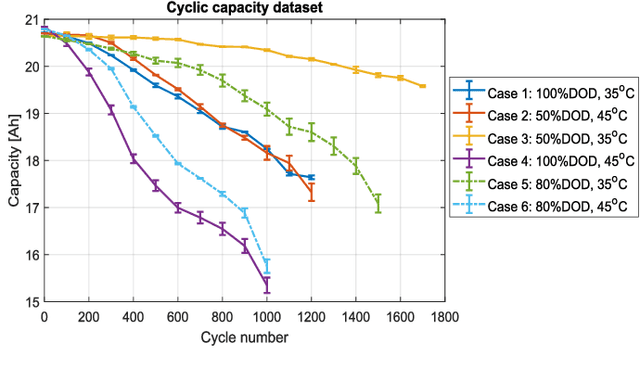
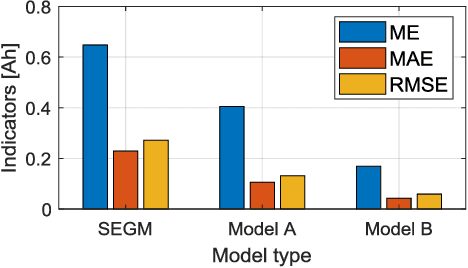
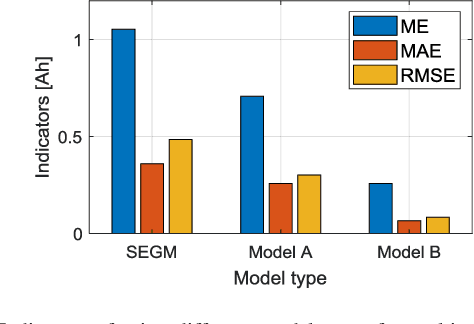
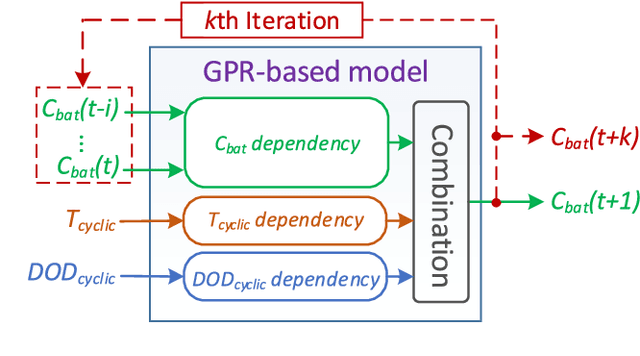
Abstract:This paper presents the development of machine learning-enabled data-driven models for effective capacity predictions for lithium-ion batteries under different cyclic conditions. To achieve this, a model structure is first proposed with the considerations of battery ageing tendency and the corresponding operational temperature and depth-of-discharge. Then based on a systematic understanding of covariance functions within the Gaussian process regression, two related data-driven models are developed. Specifically, by modifying the isotropic squared exponential kernel with an automatic relevance determination structure, 'Model A' could extract the highly relevant input features for capacity predictions. Through coupling the Arrhenius law and a polynomial equation into a compositional kernel, 'Model B' is capable of considering the electrochemical and empirical knowledge of battery degradation. The developed models are validated and compared on the Nickel Manganese Cobalt Oxide (NMC) lithium-ion batteries with various cycling patterns. Experimental results demonstrate that the modified Gaussian process regression model considering the battery electrochemical and empirical ageing signature outperforms other counterparts and is able to achieve satisfactory results for both one-step and multi-step predictions. The proposed technique is promising for battery capacity predictions under various cycling cases.
Human-like Energy Management Based on Deep Reinforcement Learning and Historical Driving Experiences
Jul 16, 2020



Abstract:Development of hybrid electric vehicles depends on an advanced and efficient energy management strategy (EMS). With online and real-time requirements in mind, this article presents a human-like energy management framework for hybrid electric vehicles according to deep reinforcement learning methods and collected historical driving data. The hybrid powertrain studied has a series-parallel topology, and its control-oriented modeling is founded first. Then, the distinctive deep reinforcement learning (DRL) algorithm, named deep deterministic policy gradient (DDPG), is introduced. To enhance the derived power split controls in the DRL framework, the global optimal control trajectories obtained from dynamic programming (DP) are regarded as expert knowledge to train the DDPG model. This operation guarantees the optimality of the proposed control architecture. Moreover, the collected historical driving data based on experienced drivers are employed to replace the DP-based controls, and thus construct the human-like EMSs. Finally, different categories of experiments are executed to estimate the optimality and adaptability of the proposed human-like EMS. Improvements in fuel economy and convergence rate indicate the effectiveness of the constructed control structure.
HCRS: A hybrid clothes recommender system based on user ratings and product features
Nov 25, 2014



Abstract:Nowadays, online clothes-selling business has become popular and extremely attractive because of its convenience and cheap-and-fine price. Good examples of these successful Web sites include Yintai.com, Vancl.com and Shop.vipshop.com which provide thousands of clothes for online shoppers. The challenge for online shoppers lies on how to find a good product from lots of options. In this article, we propose a collaborative clothes recommender for easy shopping. One of the unique features of this system is the ability to recommend clothes in terms of both user ratings and clothing attributes. Experiments in our simulation environment show that the proposed recommender can better satisfy the needs of users.
 Add to Chrome
Add to Chrome Add to Firefox
Add to Firefox Add to Edge
Add to Edge